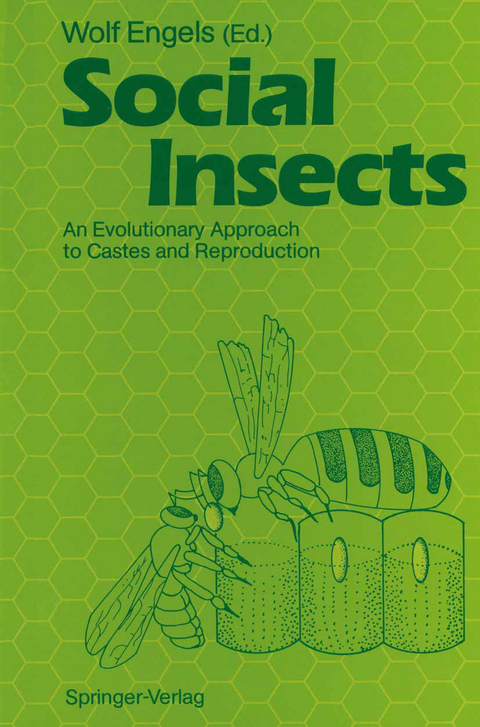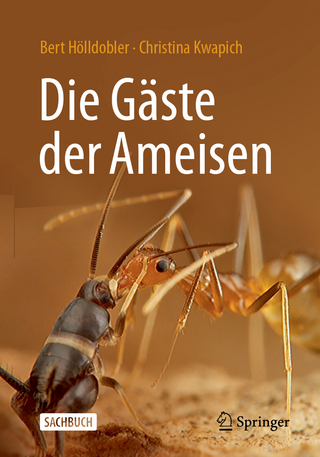
Social Insects
An Evolutionary Approach to Castes and Reproduction
Seiten
2011
|
1. Softcover reprint of the original 1st ed. 1990
Springer Berlin (Verlag)
978-3-642-74492-1 (ISBN)
Springer Berlin (Verlag)
978-3-642-74492-1 (ISBN)
Evolution of Castes in Insects l BERNHARD RENSCH The evolution of organisms in the succession of generations has been primarilly achieved through the appearance of new hereditary variants with minor deviations along with the development of stable structures and functions. Harmful mutants were eradicated either immediately or in the subsequent generations through the process of natural selection while unharmful or advantageous ones usually survived. As this process continued, many new races and species developed which possessed structures and functions of a rational nature and which became increasingly independent from their environment. These evolutionary tendencies were also promoted through either geographical, ecological, physiological or genetical isolation of populations. In some phylogenetic lines, there occurred an increase in the number of cells due to additional cellular divisions in the morphogenesis of structures. This opened up the possibility for the development of the division of labour within cellular groups leading to more complicated and consequently more successful functions of tissues and organs. A further advancement in the adaptation of a species to its environment was made possible through specialization for certain functions of whole individuals or groups of individuals.
Foreword Evolution of Castes in Insects.- Preface Perception of Caste Problems.- 1 Sexual Castes and Reproductive Strategies in Termites.- 2 Regulation of Worker and Queen Formation in Ants with Special Reference to Reproduction and Colony Development.- 3 Physiology and Reproduction in Social Wasps.- 4 Reproduction and Castes in Social Halictine Bees.- 5 Castes in Xylocopine Bees.- 6 Castes and Reproduction in Bumblebees.- 7 Caste Development, Reproductive Strategies, and Control of Fertility in Honey Bees and Stingless Bees.- 8 Differentiation in Reproductive Physiology and Behaviour During the Development of Laying Worker Honey Bees.- 9 Regulatory Steps in Caste Development of Eusocial Bees.- List of Contributors.
| Erscheint lt. Verlag | 13.12.2011 |
|---|---|
| Mitarbeit |
Assistent: A. Buschinger, R.M. Crewe, W. Engels, K. Hartfelder, C.G.J. van Honk, V.L. Imperatriz-Fonseca, C.D. Michener, C. Noirot, P.-F. Röseler, F. Ruttner, A. Strambi, H.H.W. Velthuis |
| Vorwort | Bernhard Rensch |
| Zusatzinfo | V, 265 p. |
| Verlagsort | Berlin |
| Sprache | englisch |
| Maße | 155 x 235 mm |
| Gewicht | 422 g |
| Themenwelt | Naturwissenschaften ► Biologie ► Humanbiologie |
| Naturwissenschaften ► Biologie ► Zellbiologie | |
| Naturwissenschaften ► Biologie ► Zoologie | |
| Schlagworte | Bienen • Development • Ethology • Evolution • Insects • Insekten • perception • Physiology • Regulation • Reproduction • Social behavior • Sozialverhalten • Sozioevolution • Termiten |
| ISBN-10 | 3-642-74492-3 / 3642744923 |
| ISBN-13 | 978-3-642-74492-1 / 9783642744921 |
| Zustand | Neuware |
| Haben Sie eine Frage zum Produkt? |
Mehr entdecken
aus dem Bereich
aus dem Bereich
23 Techniken, um Stress abzubauen, Negativspiralen zu unterbrechen …
Buch | Softcover (2023)
FinanzBuch Verlag
18,00 €
produktiv sein ohne Stress – und mehr vom Leben haben
Buch | Softcover (2023)
dtv Verlagsgesellschaft
18,00 €
Wie Myrmecophile mit ihren Wirten interagieren
Buch | Softcover (2023)
Springer (Verlag)
69,99 €


